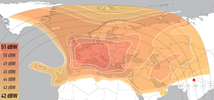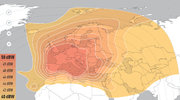Maybe only coincidence\weather etc, but never seen 12034 v that strong (T90).
My receiver is noting a 1.5 to 2db SNR increase on this transponder for me compared to 9A - will be interesting to see how it copes with rain fade.
What is the actual point of all these beams? They are now so wide that most overlap each other so can't be used for frequency reuse as they would interfere with each other. Remember Eutelsat have only published the footprint beams to 49dBW so realistically they will go much further as we are already seeing so also not that much use for restricting signals for copyright reasons.
Looking at the footprints, the Italian & Nordic/Baltic beams it
might be possible to have them for frequency reuse for each beam. But other than that there's no reason to either beams German beam, nor the Greek beam simply being put in place for frequency reuse as no other beam available could do that - the only benefit appears to be restriction in coverage. I could see a point in it if there was a Middle East or maybe even an MENA beam that could reuse frequencies on the German A beam, or maybe an Iberian beam; but there's nothing for either areas that we know.
The only other thing I could think for such beams are that the actual max ERP on the centre of these beams are significantly stronger than what Eutelsat are publishing (similar to how Eutelsat indicate stronger dbW levels on the Astra 2E & 2F spot beams as opposed to SES) and that for the Italian & Nordic/Baltic beams they are offering an opportunity for broadcasters to use 9 east for broadcasts into these areas with a 4 degree monobloc LNB? (13E for the former, 5E for the latter?)






